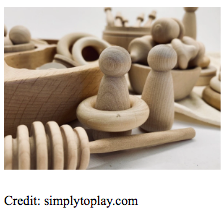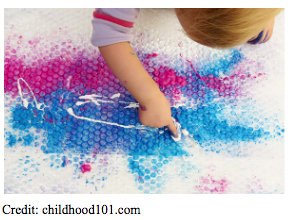This post is co-authored by Cristina Sarmiento and Emily Neer.
A one-year-old infant, Alex, sees their mother walk into the room. Alex, holding on to a small table with their left hand and shaking a toy rattle in their right hand, smiles at the rattling sound coming from inside the toy. In order to show their mom their exciting toy, Alex lets go of the table and starts walking towards her. When Alex gets to their mom, they hold up the toy to show her and she starts shaking the toy rattle to Alex’s delight.
The scenario above is an example of a child’s play with a toy and a caregiver. Play is important for young children because through play, they learn about the world around them. From an early age, children are more independent and competent than we typically think (California Department of Education, 2009). They do things in their own way in their own time, making each child’s development unique. And what may seem like an ordinary moment for an adult holds vital information for a young child (Forman et al., 2001). In the scenario above, the adult may just think the child is interested in sharing a toy with them. However, these actions are supporting a child’s cognitive, motor, and social development.
-
The child’s cognitive development is supported as the child shakes the toy and learns about cause and effect. They begin to understand that if they shake the toy, it will produce rattling sounds. Over time, they will learn that their own actions have effects.
-
The child’s practice of walking independently and fluently supports their motor development.
-
Lastly, the interaction between the caregiver and the child in which the child shares their toy supports the development of important social skills. Due to this positive and contingent interaction with their mom, the child is more likely to seek out future play opportunities with them and even learn words to describe their play (Bornstein et al., 2014; Tamis-LeMonda et al., 2014).
The toys that children choose to play with is one important part of play interactions. Two approaches to caring and educating children, the Montessori approach and the Reggio Emilia approach, each stress important qualities of play environments including the types of toys in these environments. A key component of the Montessori approach is being child-directed, in which children decide what activity they will engage in, guided by their own choices and the structure of the classroom environment. The toys are simple, made of natural materials such as wood, and encourage play.
The Reggio Emilia approach is very similar to the Montessori approach in the sense that children’s abilities to direct their own learning and actively participate in guided environments is highly valued. Teachers guide children’s play towards the child’s interests and current developmental stage by the toys they provide for the child. For example, a parent may notice that their child has become interested in pressing buttons on the TV remote. A parent can encourage this interest by creating an inexpensive, fun learning experience for their child by taping bubble wrap to a small, rectangular piece of cardboard. This experience, enhanced with new textures and sounds, would allow the child to explore their interest of pushing buttons by trying to pop the bubbles on the bubble wrap. It would also help them practice their fine motor skills as they learn to apply the right amount of pressure to pop the bubble wrap. Parents and caregivers can even add a bit of different colored paint for a more sensory experience!
Influenced by the Reggio Emilia approach, it is best to take these ordinary play moments with children and look at them closely to better understand the child’s interests and current developmental stage. Play not only happens in a school setting, but also at home with caregivers and siblings. When at home, have you noticed that children will sometimes choose common household objects over store-bought toys? Like how a child can have a room full of store-bought toys but would prefer to play with food containers or a TV remote?
In fact, children’s toys do not have to be expensive. The best toys are those that are healthy and safe, developmentally appropriate, and open-ended.
-
Healthy and safe toys refer to toys that are non-toxic and do not have harmful chemicals, such as BPA and DEHP (Shabazian & Soga, 2014). It is also important that toys do not contain sharp edges and small parts that are choking hazards.
-
Developmentally appropriate means that the toys are right for children’s current developmental stage and are neither too easy nor too complex. For example, a 50 piece puzzle would not be developmentally appropriate for an infant or toddler. Rather, a wooden animal shape puzzle is developmentally appropriate for a younger toddler.
-
Finally, open-ended toys are toys that do not have a specific purpose. It leaves the purpose up to the child and enhances divergent thinking, taking different perspectives to solve problems, and problem-solving skills (Shabazian & Soga, 2014). The child chooses what they want to do with the toy, thus providing themselves with opportunities that support various areas of development (e.g., cognitive, motor, language, social, emotional).
Furthermore, toys should have appealing appearances, sounds, and textures. The appeal will encourage participation of play, leading to children’s development. Handmade toys are also great toys because of their unique appearances, textures, and possible sounds. Handmade toys can be made from readily available materials such as fabric (e.g., sock puppets) or boxes (e.g., cereal boxes made into larger blocks) (Guyton, 2011).
It is also important to note that all toys do not need to be open-ended. Puzzles are a great toy that has a single-end goal and facilitates cognitive development (e.g., shapes, mental rotation of shapes) and motor development (e.g., fine motor skills) (Guyton, 2011). Puzzles can also be handmade out of readily available materials such as egg cartons!
In conclusion, we should be conscious of the toys we choose for children and keep in mind what will help stimulate their growth and development. Some, if not most toys, should be open-ended to continue to facilitate children’s development, creativity, independence, and problem solving. As long as toys are safe, they can be handmade with readily available materials, or store-bought. The most important factors to keep in mind are that toys are developmentally appropriate and fun for your child!
References
Bornstien, M. H., Arterberry, M. E., & Lamb, M. E. (2014). Development in infancy: A contemporary introduction. Psychology Press.
California Department of Education (2009). California infant/toddler learning and development foundations. CDE Press.
Forman, G., Hall, E., & Berglund, K. (2001). The power of ordinary moments. Child Care Information Exchange, 9, 52-55.
Guyton, G. (2011). Using toys to support infant-toddler learning and development. Young Children, 66, 50-59.
Shabazian, A. N., & Soga, C. L. (2014). Making the right choice simple: Selecting materials for infants and toddlers. Young Children, 69, 60-65.
Tamis-LeMonda, C. S., Kuchirko, Y., & Song, L. (2014). Why is infant language learning facilitated by parental responsiveness? Current Directions in Psychological Science, 23(2), 121-126. https://doi.org/10.1177/0963721414522813


